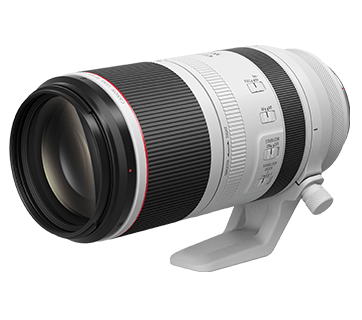Canon - RF100-500mm f/4.5-7.1L IS USM Lens
The Canon RF100-500mm f/4.5-7.1L IS USM is a versatile telephoto zoom lens for Canon's RF mount mirrorless cameras. Designed with professionals and advanced enthusiasts in mind, it combines a broad zoom range with high-quality optics, making it ideal for wildlife, sports, and action photography.
Key Features
1. Focal Length:
- 100-500mm range, excellent for capturing distant subjects.
- Effective 160-800mm range on APS-C cameras.
2. Aperture Range:
- Maximum: f/4.5 at 100mm to f/7.1 at 500mm.
- Minimum: f/32 to f/54.
- Great for daylight and well-lit environments but less suited for low-light conditions.
3. Optical Design:
- 20 elements in 14 groups.
- Includes 6 Ultra-Low Dispersion (UD) elements and 1 Super UD element to minimize chromatic aberrations and enhance sharpness.
- Canon’s Air Sphere Coating (ASC) reduces ghosting and flaring.
4. Image Stabilization:
- Up to 5 stops of shake correction with the built-in Optical Image Stabilizer.
- Coordinated IS with in-body stabilization on compatible Canon mirrorless cameras, offering even better stabilization.
5. Autofocus:
- Dual Nano USM (Ultrasonic Motor) system ensures smooth, fast, and quiet autofocus.
- Compatible with EOS iTR AF for subject tracking in Canon mirrorless cameras.
6. Build and Durability:
- L-series build quality: Dust and water resistance for challenging environments.
- Heat-resistant white coating on the barrel.
- Weight: 1365g (3.01 lbs.) without the tripod mount.
- Dimensions: 207.6mm (8.17 inches) in length.
7. Controls:
- Focus range limiter switch for quicker autofocus in specific ranges (3m–∞ or full range).
- Customizable Control Ring for quick adjustments like ISO, aperture, or exposure compensation.
- Zoom lock switch prevents lens creep.
8. Teleconverter Compatibility:
- Compatible with 1.4x and 2x teleconverters, extending the focal length up to 700mm and 1000mm respectively.
- Aperture reduces to f/10 or f/14 at maximum zoom with teleconverters.
9. Bokeh:
- 9-blade circular aperture produces smooth and pleasing background blur.
10. Close Focus:
- Minimum focusing distance: 0.9m (100mm) to 1.2m (500mm).
- Maximum magnification: 0.33x at 500mm.
Advantages
Versatile Focal Range:
- Covers a broad range of photography genres, from wildlife and sports to landscapes.
Compact and Lightweight:
- Relatively portable compared to super-telephoto primes with similar range.
Exceptional Image Quality:
- Advanced optics deliver sharpness and accurate color reproduction across the zoom range.
Effective Stabilization:
- Highly useful for handheld shooting, especially at longer focal lengths.
Professional Build:
- Robust design for harsh environments.
Smooth Autofocus:
- Ideal for both stills and video due to the silent Nano USM system.
Compatibility with Teleconverters:
- Extends focal length significantly for super-telephoto needs.
Disadvantages
Limited Aperture:
- Narrow aperture (f/7.1 at 500mm) restricts low-light performance and depth-of-field control.
Price:
- High cost, typically around $2,899 USD or ₹2,50,000 INR may deter non-professionals.
Teleconverter Trade-offs:
- Adding teleconverters further reduces the maximum aperture, which can limit autofocus performance and light transmission.
No Internal Zooming:
- Extending barrel during zooming can make handling slightly less stable.
Heavy:
- While relatively light for a lens of this range, it may still be cumbersome for prolonged handheld use.
Best Use Cases
- Wildlife Photography: The extended range and sharp optics make it perfect for capturing animals at a distance.
- Sports Photography: Fast autofocus and stabilization help track fast-moving subjects.
- Travel and Landscape: Versatility in capturing distant vistas or tight telephoto landscapes.
Conclusion
The Canon RF100-500mm f/4.5-7.1L IS USM is a high-performing, versatile lens with outstanding image quality and build for professionals and advanced hobbyists. While the narrow aperture can be a limitation in certain conditions, its stabilization, focal range, and teleconverter compatibility make it a valuable addition to the RF lens lineup.

Comments
Post a Comment